Wats west of Phnom Penh
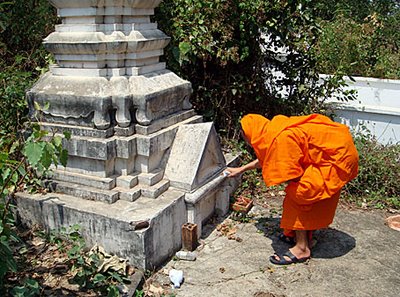 Kumtoung, the head monk of Wat Tang Krasang Cheung inspects a chedi inscription
Kumtoung, the head monk of Wat Tang Krasang Cheung inspects a chedi inscriptionYes that's right, I went visiting a series of Wats west of Phnom Penh earlier today, making use of my Ministry of Culture/EFEO map of Kandal province to see what I could unearth fairly close to home. On the way towards Pochentong, I called into Wat Toek Thla, the first of eight pagodas on my brief jaunt. I couldn't find much except a disused Lao-style pagoda in the shadow of the large ornate modern vihara, so moved on quickly, leaving the main road and heading out into the dusty countryside for my next stop, at Wat Tang Krasang Cheung, situated next to another wat, Tang Krasang Thbong. The head monk, Kumtoung, led me around the back of a series of private stupas to show me at least half a dozen brick stupas, festooned with weeds and undergrowth, and some with a concrete covering and outlined an inscription that said the chedi were built in 1280, though some of them looked like they'd been rebuilt since then. We sat and had a drink of tea as I gave him a few copies of the book I am handing out to monks and teachers that I meet on my travels, Buddhist Ethics in Daily Life. He pointed me in the direction of an old tree and small Neak Ta spirit house at Tuol Prei Sala and after that I headed along the railway line towards Wat Krang Thnong.
The pedestal that I expected to find was too well hidden for my beady eyes, so I moved onto Wat Chum, which was much more generous in its offerings. Sat under one of the pagoda's old trees was half of a lintel, most likely carved in the Sambor Prei Kuk era, that had been white-washed. Inside a Neak Ta spirit house, most of the other half of the lintel resided. Nearby were two sandstone pedestals but nothing else, despite an exhaustive search of the grounds of the pagoda. In the next village, Wat Chhouk Va hosted a light picnic after I stopped to buy some cooked-on-the-spot sausage, beef and vegetables, as well as a pedestal inside a stupa and some old-looking chedis. Passing the Royal Phnom Penh golf course, Wat Tekkhabanhor beckoned, but apart from some seima stones from the year of the pagoda's construction, 1953, and a very friendly head monk, Ham Sovann, there was nothing else of note. At Wat Arun Vatei I found a small fragment from a lintel lying in the grass near the vihara and at Wat Kok Banhchan, some laterite blocks looked promising but aside from watching some monks putting their backs into some manual labour, my search for further treasures proved fruitless and I headed for home. I was never further than about 25 kms from the city and whilst i didn't unearth any major discoveries, its was a pleasant Sunday afternoon diversion along rural roads that see virtually no foreigners whatsoever.
The pedestal that I expected to find was too well hidden for my beady eyes, so I moved onto Wat Chum, which was much more generous in its offerings. Sat under one of the pagoda's old trees was half of a lintel, most likely carved in the Sambor Prei Kuk era, that had been white-washed. Inside a Neak Ta spirit house, most of the other half of the lintel resided. Nearby were two sandstone pedestals but nothing else, despite an exhaustive search of the grounds of the pagoda. In the next village, Wat Chhouk Va hosted a light picnic after I stopped to buy some cooked-on-the-spot sausage, beef and vegetables, as well as a pedestal inside a stupa and some old-looking chedis. Passing the Royal Phnom Penh golf course, Wat Tekkhabanhor beckoned, but apart from some seima stones from the year of the pagoda's construction, 1953, and a very friendly head monk, Ham Sovann, there was nothing else of note. At Wat Arun Vatei I found a small fragment from a lintel lying in the grass near the vihara and at Wat Kok Banhchan, some laterite blocks looked promising but aside from watching some monks putting their backs into some manual labour, my search for further treasures proved fruitless and I headed for home. I was never further than about 25 kms from the city and whilst i didn't unearth any major discoveries, its was a pleasant Sunday afternoon diversion along rural roads that see virtually no foreigners whatsoever.
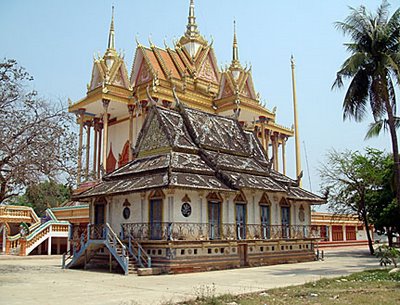
A Lao-style pagoda at Wat Toek Thla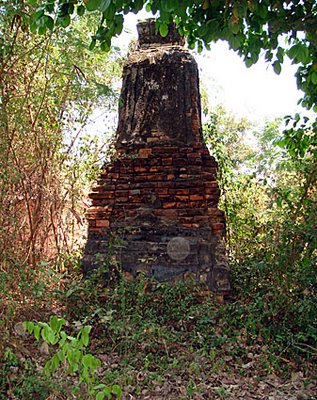

One of the brick-built stupas at Wat Tang Krasang Cheung, dating from 1280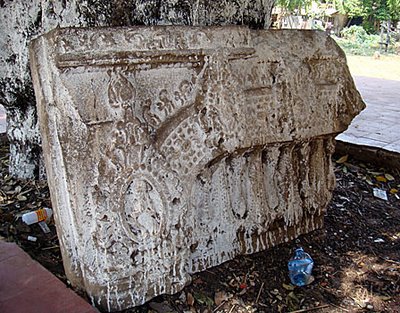
The white-washed Sambor Prei Kuk era lintel at Wat Chum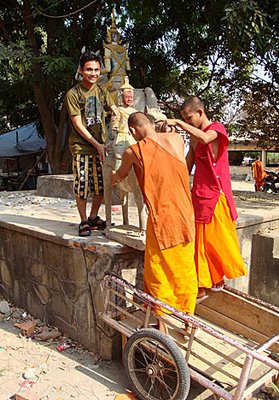
Two young monks putting their backs into moving a statue at Wat Kok Banhchan


0 Comments:
Post a Comment
<< Home